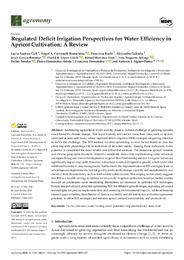Título :
Regulated Deficit Irrigation Perspectives for Water Efficiency in Apricot Cultivation: A Review |
Autor :
Hernández, Francisca
Andreu Coll, Lucía 
Carbonell-Barrachina, Ángel A.
Burló, Francisco 
López Lluch, David 
Galindo, Alejandro
GARCIA BRUNTON, JESUS 
Martínez Font, Rafael
Noguera-Artiaga, Luis
Sendra, Esther
Signes-Pastor, Antonio Jose  |
Editor :
MDPI |
Departamento:
Departamentos de la UMH::Producción Vegetal y Microbiología |
Fecha de publicación:
2024-05 |
URI :
https://hdl.handle.net/11000/32392 |
Resumen :
Addressing agricultural water scarcity poses a current challenge of growing concern,
exacerbated by climate change. This is particularly relevant for stone fruit trees, such as apricot,
cultivated in semi-arid zones, where regulated deficit irrigation (RDI) strategies are gaining attention
to tackle the challenge. The RDI method involves optimizing various factors based on how the
plant responds physiologically to indicators of its water needs. Among these indicators, water
potential is considered the most reliable and influential measure. For numerous apricot varieties
and diverse geographic locations, research consistently shows that implementing water reduction
strategies during non-critical developmental stages of floral bud development or fruit growth does not
significantly impact crop yield. However, it does lead to reduced vegetative growth, which could offer
additional benefits in crop management. Furthermore, the implementation of RDI strategies leads to
advantageous improvements in fruit quality, particularly storage capacity and morphometric and
chemical fruit characteristics, such as total soluble solids content. This scoping review study suggests
that RDI is a feasible strategy to address water scarcity in apricot cultivation; however, further studies
focused on continuous water monitoring alternatives are necessary to optimize RDI techniques.
Future research should prioritize optimizing RDI for different growth stages, exploring advanced
technologies for precise implementation, and assessing environmental impacts, while addressing
research gaps including the influence of climate variability and the interaction with other agronomic
practices, to refine RDI strategies and enhance apricot orchard sustainability and productivity
|
Palabras clave/Materias:
Prunus armeniaca
water saving
water potential
crop productivity
stone fruit |
Área de conocimiento :
CDU: Ciencias aplicadas: Agricultura. Silvicultura. Zootecnia. Caza. Pesca |
Tipo de documento :
info:eu-repo/semantics/article |
Derechos de acceso:
info:eu-repo/semantics/openAccess |
DOI :
https://doi.org/10.3390/agronomy14061219 |
Publicado en:
Agronomy 2024, 14 |
Aparece en las colecciones:
Artículos - Producción vegetal y microbiología
|
 La licencia se describe como: Atribución-NonComercial-NoDerivada 4.0 Internacional.
La licencia se describe como: Atribución-NonComercial-NoDerivada 4.0 Internacional.
.png)
